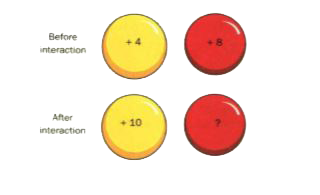Explain the law of conservation of charge with an example.
Step-by-Step Solution:
1. State the Law of Conservation of Charge:
The law of conservation of charge states that charge cannot be created or destroyed. It can only be transferred from one object to another. This means that the total charge in an isolated system remains constant over time.
2. Identify the Initial Charges:
Consider two spheres:
- Sphere A is initially uncharged (0 coulombs).
- Sphere B has a charge of -8 coulombs.
3. Calculate the Total Initial Charge:
The total initial charge of the system can be calculated as:
Total Initial Charge=Charge of Sphere A+Charge of Sphere B=0+(−8)=−8 coulombs
4. Touch the Spheres:
When the two spheres are touched together, charge can flow between them due to conduction. The charge will redistribute itself between the two spheres.
5. Determine the Final Charges:
After touching and then separating the spheres, the charge will redistribute evenly. Since the total charge is -8 coulombs and there are two spheres, each sphere will end up with:
Charge on Sphere A=Charge on Sphere B=−8 coulombs2=−4 coulombs
6. Calculate the Total Final Charge:
Now, calculate the total charge after the spheres have been separated:
Total Final Charge=Charge of Sphere A+Charge of Sphere B=−4+(−4)=−8 coulombs
7. Conclusion:
The total charge before and after the interaction remains the same (-8 coulombs). This illustrates the law of conservation of charge, as the charge was neither created nor destroyed, but simply transferred between the two spheres.
---
The law of conservation of charge states that charge cannot be created or destroyed. It can only be transferred from one object to another. This means that the total charge in an isolated system remains constant over time.
Consider two spheres:
- Sphere A is initially uncharged (0 coulombs).
- Sphere B has a charge of -8 coulombs.
The total initial charge of the system can be calculated as:
Total Initial Charge=Charge of Sphere A+Charge of Sphere B=0+(−8)=−8 coulombs
When the two spheres are touched together, charge can flow between them due to conduction. The charge will redistribute itself between the two spheres.
After touching and then separating the spheres, the charge will redistribute evenly. Since the total charge is -8 coulombs and there are two spheres, each sphere will end up with:
Charge on Sphere A=Charge on Sphere B=−8 coulombs2=−4 coulombs
Now, calculate the total charge after the spheres have been separated:
Total Final Charge=Charge of Sphere A+Charge of Sphere B=−4+(−4)=−8 coulombs
The total charge before and after the interaction remains the same (-8 coulombs). This illustrates the law of conservation of charge, as the charge was neither created nor destroyed, but simply transferred between the two spheres.
Topper's Solved these Questions
Similar Questions
Knowledge Check
Explain the Law of segregation
AThe two members of a pair of factors join during the formation of gametes.BThe two members of a pair of factors separate during the formation of gametes.CThe two chromosomes of a pair of factors separate during the formation of gametes.DThe two members of a pair of factors separate during the process of germinationExplain the Law of segregation
AThe two members of a pair of factors join during the formation of gametes.BThe two members of a pair of factors separate during the formation of gametes.CThe two chromosomes of a pair of factors separate during the formation of gametes.DThe two members of a pair of factors separate during the process of germination.According to law of conservation of mass:
Areactants mass = products massBgases are lighter than solidsCkinetic energy changes with heatDreactants + oxygen = products
Define the law of conservation of energy.
View SolutionExplain the law of addition of vectors.
View SolutionBy giving an example, state and explain the law of conservation of energy.
View SolutionWhat is the law of conservation of energy?
View SolutionFigure D shows two spheres that initially have +4 and +8 positive charge. After an interaction (which could simply be that they touch each other), the yellow sphere has +10 positive charge, and the red sphere has an unknown quantity of charge. Use the law of conservation of charge to find the final charge on the red sphere.

View Solution